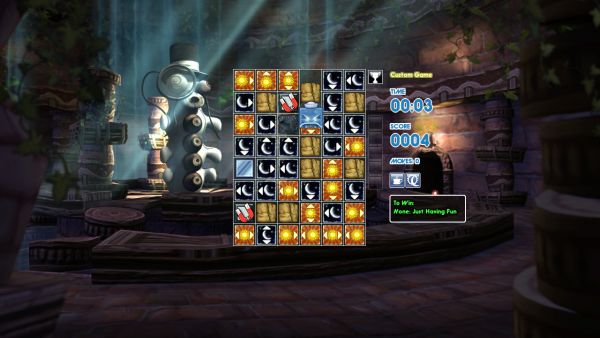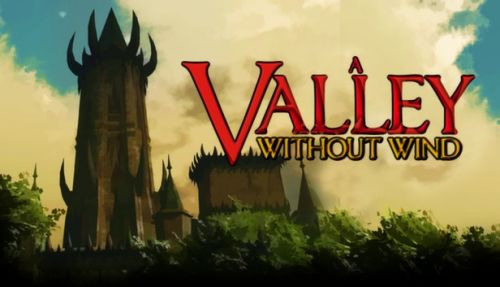
Tidalis was, at first glance, a puzzle game in the vein of Bejewled; but there was more lurking under the surface...
Co-Optimus: So the other theme is a personal favorite of ours at this site: the inclusion of co-op. Why do it? Doesn’t that make things harder?
Chris: I actually wrote a lengthy blog post about this back in 2009, and you guys quoted me quite a bit in an article you wrote in ‘09 or ‘10 on the same subject. It’s a complex topic.
That said, the high points are: players just aren’t playing in isolation anymore, because large segments are growing up, getting married, having kids, etc. Often the choice is “play together or not at all,” so co-op to me seems very near to a required feature.
To me it doesn’t need to be something grandly different from the solo experience. It’s just “I see you playing that, and I want to play too.” Not “I see you playing that, and let’s play a watered-down version of that that together, and then later you can go back to playing solo.” I think sometimes developers are making it more complex than it needs to be, trying to make the co-op experience something distinct from solo. Just let me and my wife both play through the main game together!
In terms of co-op making development harder, naturally it does. Networked multiplayer is a huge bugbear, and something a lot of indies don’t want to touch with a ten-foot pole. However, once you’ve done it once or twice, it becomes pretty routine. It’s still the largest source of bugs, and by far the largest source of tech support requests (people requesting router/ISP/config help, not reporting bugs). But to me it’s worth it.
Co-Optimus: Any chance we’ll see a console port of any of Arcen Games’ titles?
A: There’s definitely a chance, although there’s nothing in the works right now. We’ve had some great conversations with Sony as well as some various major publishers about everything from Playstation to Vita to Wii U. Nothing has really come of that yet, but we have some great contacts that we keep in touch with every so often.
My main point of resistance is that I don’t personally have much motivation to work on ports. I’m a game designer and a coder, and the thought of spending months on just a port is a bit... well, depressing. It would be a new source of revenue, sure, but there are a lot of hoops to jump through for that revenue on any console, and a lot of time spent not focusing on what we do best: designing and implementing games.
I recall Introversion mentioning how getting bogged down in endless ports was really a major stumbling block for them, and I’ve always taken that to heart. With the right partners, or with being able to take on staff dedicated to ports without impacting our core development team, I’d certainly be all for ports. I’d absolutely love to see our games on consoles, tablets, and phones. But really doing that right takes a lot of time, and in that same amount of time we can make a good chunk of a new game.

Arcen's next big game was the cryptically named "A Valley Without Wind"
Co-Optimus: Ok, the broad/general questions out of the way, let’s focus a little more on A Valley Without Wind 2. What did you learn from A Valley Without Wind that went into making the sequel?
Chris: Valley 1 started out with a design much more similar to Valley 2. However, we couldn’t really figure out the best way to get the strategic elements to gel with the main gameplay, so that kind of sloughed off during early beta of Valley 1. We also started putting in a bunch of crafting mechanics, which weren’t in the original design, because I thought that would be fun and interesting. It was -- but it also really took over the flow of the game and turned it into something that I hadn’t expected.
There are people who prefer Valley 1, and goodness knows I really enjoy the game as well. But it was a lot more of a sandbox than I had intended, without any real overarching plot of significance, or any satisfying conclusion. It was just an endless sandbox: great fun for a large number of hours, but then at some point you just have to put it down without feeling like you “finished,” because there is no finish.
With Valley 2, we stripped away the endless nature, the generic characters affected by permadeath, and all the crafting and sandboxiness. Instead we focused on tighter, more tactical combat with higher stakes for a single character that you control throughout the whole game. There’s a lot more individual character progression on a defined arc that has a specific beginning, middle, and end.
There are lots of loadout customization choices (50, in fact), but it’s not completely freeform. This actually makes for more interesting spells, because we can balance the loadouts against one another rather than each of 200 spells against every other loadout. That was something I much preferred to the crafting approach, in the end. And then of course we finally figured out how to integrate the strategy portions properly, and came up with a much better strategy design in general. Valley 2 is larger in scope than Valley 1 in most respects, but it’s also a lot more focused.
Co-Optimus: Why didn’t these improvements just go into a patch or an update of the original?
Chris: Mainly because these were so starkly different from the first game that if we did that, it would have erased the first game entirely. These weren’t just improvements to an existing game, it was a straight-up reconceptualization. Valley 2 is more different from Valley 1 than most sequels are. To make that many changes to a game that many people already loved would have caused an enormous (and well-justified) uproar! In the end we split the difference and gave the sequel for free to to all the owners of Valley 1 (and vice-versa).